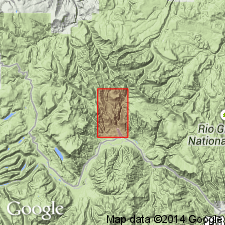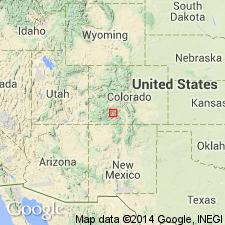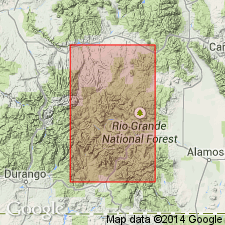
- Usage in publication:
-
- Creede formation*
- Modifications:
-
- Original reference
- Dominant lithology:
-
- Tuff
- Breccia
- Conglomerate
- AAPG geologic province:
-
- San Juan Mountains province
Summary:
Creede formation. Water-laid deposits, 0 to 2,000+/- feet thick. Upper member consists of breccia, conglomerate, and tuff with intercalated lava flows. Lower member consists of thinly laminated white shaly tuff, in part sandy and with some breccia and conglomerate, and interbedded with travertine. Plants from lower tuffs indicate correlation with Miocene Florissant lake beds. Unconformably overlain by Fisher quartz latite and unconformably underlain by Potosi volcanic series.
Named from development on slopes of both sides of Willow Creek about town of Creede, Creede district, [Creede 7.5-min quadrangle, Mineral Co.], southwestern CO. Named from town of Creede.
Source: US geologic names lexicon (USGS Bull. 896, p. 540).

- Usage in publication:
-
- Creede Formation*
- Modifications:
-
- Areal extent
- AAPG geologic province:
-
- San Juan Mountains province
Summary:
Authors have found that earlier recognized subdivisions (Larsen and Cross, 1956) are in large part laterally equivalent facies that are so complexly intermixed that it is not practical to separate them. Facies recognized are lake beds (shale, sandstone interbedded with some tuff), fluviatile sandstone and conglomerate, fanglomerate, and coarse sedimentary breccias. These were deposited in a structural trough around the margin of the domed core of the Creede caldera in the San Juan Mountain province. Is at least 2,400 ft thick. Extends from Lime Creek, down the Rio Grande to Wagon Wheel Gap and up Goose Creek for nearly 5 mi. Assigned to the middle and late Tertiary, and younger than the Snowshoe Mountain Quartz Latite.
Source: GNU records (USGS DDS-6; Denver GNULEX).

- Usage in publication:
-
- Creede Formation*
- Modifications:
-
- Age modified
- AAPG geologic province:
-
- San Juan Mountains province
Summary:
Pg. D49 (table 1), D51. Creede Formation. Age changed from middle or late Tertiary --to-- Oligocene. (Adopted by USGS.) Well preserved plant flora, of local occurence, have been assigned from Miocene to Pliocene age. [On p. D49 (table 1) shown as age-equivalent of Fisher Quartz Latite (26.4 Ma).]
Source: Changes in stratigraphic nomenclature, 1968 (USGS Bull. 1294-A, p. A6).
For more information, please contact Nancy Stamm, Geologic Names Committee Secretary.
Asterisk (*) indicates published by U.S. Geological Survey authors.
"No current usage" (†) implies that a name has been abandoned or has fallen into disuse. Former usage and, if known, replacement name given in parentheses ( ).
Slash (/) indicates name conflicts with nomenclatural guidelines (CSN, 1933; ACSN, 1961, 1970; NACSN, 1983, 2005, 2021). May be explained within brackets ([ ]).

